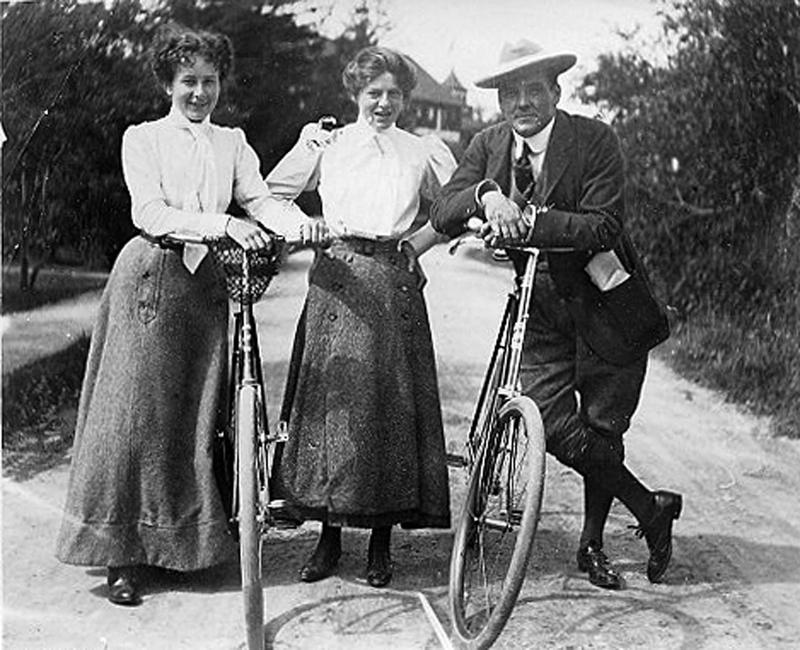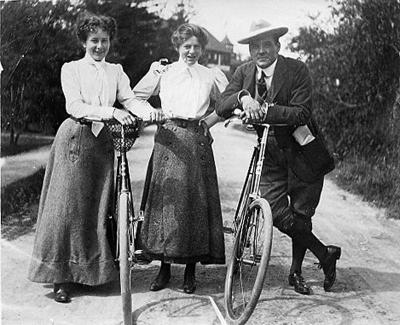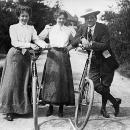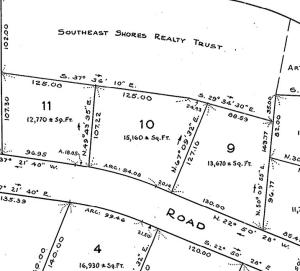Local art historians reflect on Cecil Clark Davis
 Local art historian and author of “Cecil Clark Davis: A Self Portrait (1877-1955)”, and former executive director at the Marion Art Center Wendy Bidstrup, stands next to Cecil Clark Davis’s self portrait in the Marion Art Center.
Local art historian and author of “Cecil Clark Davis: A Self Portrait (1877-1955)”, and former executive director at the Marion Art Center Wendy Bidstrup, stands next to Cecil Clark Davis’s self portrait in the Marion Art Center. Famous portrait painter Cecil Clark Davis (center) in Marion, alongside husband and noted war journalist Richard Harding Davis (right) and best friend, and famous actress, Ethel Barrymore (left).
Famous portrait painter Cecil Clark Davis (center) in Marion, alongside husband and noted war journalist Richard Harding Davis (right) and best friend, and famous actress, Ethel Barrymore (left).  Marion art historian and artist Nancy Mitton holds her book about Marion art history, “A Romantic Art Colony: Marion, Massachussetts” where she wrote about artists who made their mark in Marion such as Cecil Clark Davis.
Marion art historian and artist Nancy Mitton holds her book about Marion art history, “A Romantic Art Colony: Marion, Massachussetts” where she wrote about artists who made their mark in Marion such as Cecil Clark Davis.  Local art historian and author of “Cecil Clark Davis: A Self Portrait (1877-1955)”, and former executive director at the Marion Art Center Wendy Bidstrup, stands next to Cecil Clark Davis’s self portrait in the Marion Art Center.
Local art historian and author of “Cecil Clark Davis: A Self Portrait (1877-1955)”, and former executive director at the Marion Art Center Wendy Bidstrup, stands next to Cecil Clark Davis’s self portrait in the Marion Art Center. Famous portrait painter Cecil Clark Davis (center) in Marion, alongside husband and noted war journalist Richard Harding Davis (right) and best friend, and famous actress, Ethel Barrymore (left).
Famous portrait painter Cecil Clark Davis (center) in Marion, alongside husband and noted war journalist Richard Harding Davis (right) and best friend, and famous actress, Ethel Barrymore (left).  Marion art historian and artist Nancy Mitton holds her book about Marion art history, “A Romantic Art Colony: Marion, Massachussetts” where she wrote about artists who made their mark in Marion such as Cecil Clark Davis.
Marion art historian and artist Nancy Mitton holds her book about Marion art history, “A Romantic Art Colony: Marion, Massachussetts” where she wrote about artists who made their mark in Marion such as Cecil Clark Davis. Story Location
United States
MARION — Wearing a brown feathered hat, suit, and contemplative look the woman in the portrait has become forever immortalized on a canvas in the Marion Arts Center. The woman is an artist, the painting a self-portrait, and her other work, like windows in time, will forever be mounted there in the gallery’s theater.
The artist is Cecil Clark Davis, a woman known in life as not only a painter but as a revolutionary who helped set the standards as the ideal American woman of her time.
Clark Davis, a late 19th century artist who summered in Marion, was one of the few women to inspire Charles Dana Gibson, an illustrator, to create the iconic “Gibson Girl”, a romantic image of the ideal 19th and early 20th century American women which was illustrated and printed on buttons, fabric, books and posters around the world.
The Gibson Girl, according to Marion art historian and contemporary realist painter Nancy Mitton, was a strong, intelligent, educated, witty, creative, beautiful and independent American woman. To Gibson, said Mitton, Clark Davis fit that mold and he illustrated her and her husband, Richard Harding Davis, a famous and handsome socialite who later became the model for the Gibson Man.
“I think that’s what inspired me about Cecil Clark Davis- how she inspired Charles Dana Gibson’s image of the Gibson Girl,” said Mitton, who wrote about the artist in her book about Marion art history, A Romantic Art Colony: Marion, Massachussetts.
As an artist, Clark Davis painted portraits of famous people like Mark Twain and average people like her nurses, friends, gardener and housekeepers. Clark Davis knew many famous people, such as Ethel Barrymore, who according to local Marion historian Wendy Bidstrup, was her maid of honor at her wedding. The Marion artist’s paintings won awards and much of her work is at Tabor Academy and the Marion Art Center.
Clark Davis was born in 1877 in Chicago to a wealthy industrialist father. When Clark Davis was a teen, her family stayed at a hotel in Marion for the summer. Eventually, said Bidstrup, her family built a 35 acre summer mansion on Water Street so Clark Davis could keep her horse. The artist loved dogs and according to Bidstrup, owned a total of 35 dogs, each a different breed and would have at least one accompany her whenever she traveled with her husband.
“She was brave and adventuresome. People sought her counsel but she was of a privileged class.” said Bidstrup.
Clark Davis was also a woman suffragette who challenged gender norms. According to Bidstrup, Clark Davis did not want to follow the traditional path of a woman. She had no interest in marrying and having kids, as she did not want her career to end.
She only married Harding Davis because of family pressure and told him she would only marry him if they keep their relationship platonic. The two were close friends and would often travel the world together for his work as a journalist. Even after they divorced in 1912, Clark Davis would still express her care and concern for him.
Bidstrup’s interest in Davis began at Tabor Academy, where Davis’s paintings were then hung. Curious about the person behind the paintings, she asked people at Tabor Academy, but they replied that the only information they had on the painting was her name.So, Bidstrup started 25 years of research on Clark Davis. Over the years, Bidstrup interviewed people that knew the artist and even collected letters between Davis’s husband and mother about her to get a better understanding of who she was in life.
Among those she interviewed was Clark Davis’ caretaker and friend, Frederica Dibblee Poett, who resided in California after Clark Davis’ passing in 1955. In 2013, Bidstrup published a biography about Davis, compiling all of her research and work on the iconic artist. Bidstrup has an original Clark Davis painting in her house, which she said is a prized possession.
Bidstrup said she admires Clark Davis and often thinks of her whenever she walks by where the artist’s house used to be. “Quite often … I’d be walking down Water Street, go by where her house used to be and it was almost like she was saying ‘don’t forget about me, tell the story,’” said Bidstrup.
There will be a guided walking tour of Clark Davis’ work during ArtWeek on Sunday, April 28, from 2 to 4 p.m starting at the Marion Music Hall on 164 Front Street, continuing to the Sippican Historical Society and finishing at the Marion Art Center where people can talk, have tea and eat snacks.
The tour will be guided by Bidstrup and Mitton, with two other local art historians accompanying it to add to the experience.
The tour is $5 per person. Participants are asked to meet at the Music Hall before 2 p.m.

































